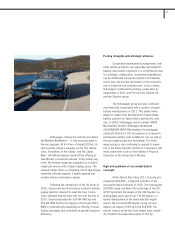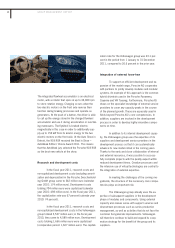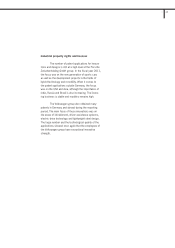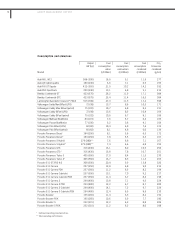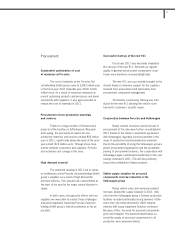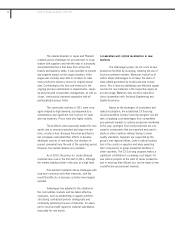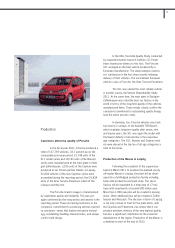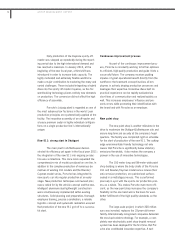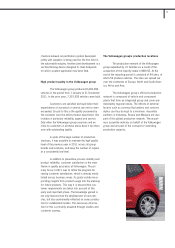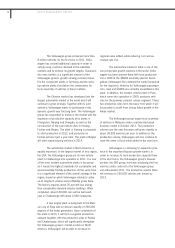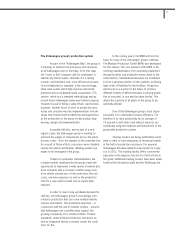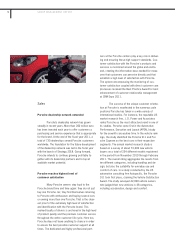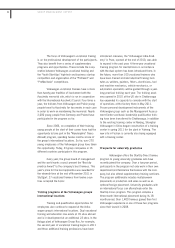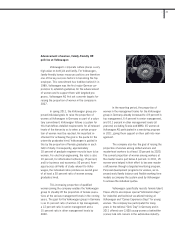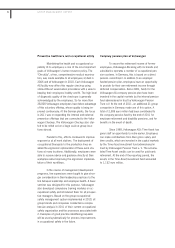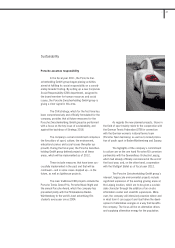Porsche 2011 Annual Report Download - page 77
Download and view the complete annual report
Please find page 77 of the 2011 Porsche annual report below. You can navigate through the pages in the report by either clicking on the pages listed below, or by using the keyword search tool below to find specific information within the annual report.
The Volkswagen group’s production system
As part of the “Volkswagen Way”, the group is
continuing to optimize the processes and structures
at all Volkswagen sites in Germany. In its first step,
the “Learn to See” program calls for employees to
identify any kind of waste, eliminate it in a lasting
manner, and introduce new, more efficient processes
to be established as standard. In the second stage,
there were events which help improve internal de-
partment and cross-departmental cooperation. This
system, which has a standard methodology and ap-
proach helps Volkswagen make even further progress
towards its goal of being a value driven, synchronous
business. Another focus of work on production proc-
esses and structure was the implementation of work-
shops that improve both productivity and ergonomics
at the workstation in the areas of new product engi-
neering, design and implementation.
In parallel with this, and as part of a new
logistics plan, the Volkswagen group is working to
optimize the supply of components across the entire
process chain – from the supplier to the assembly line.
As a result of these efforts, processes were standard-
ized across plants and brands, allowing greater syn-
ergies to be leveraged in the group.
Thanks to systematic standardization, the
modular toolkits developed by the group create the
opportunity to implement a wide variety of vehicle and
drive concepts with a minimum of effort using a uni-
form vehicle architecture. At the same time, the unit
costs, one-time expenses as well as the production
time for a new vehicle model can be significantly
reduced.
In order to meet rising worldwide demand for
vehicles, the Volkswagen group is increasingly com-
mitted to production that can cover multiple vehicle
classes and brands. This production approach – in
conjunction with the use of modular toolkits – ensures
that Volkswagen can cost-effectively support the
growing complexity of its model portfolio. Product
standards, state-of-the-art production processes as
well as integrated factory concepts create the condi-
tions for this.
In the coming years, the MQB will form the
basis for many of the Volkswagen group's vehicles.
The Modular Production Toolkit (MPB) was developed
for this reason. The core element of the MPB is far-
reaching standardization: from operating equipment
through facilities and production areas, down to the
entire factory. Standardized elements are combined
to form a growing number of new systems, achieving
high levels of flexibility for the facilities. Production
will thus be in a position in the future to produce
different models of different brands in varying quanti-
ties at one plant, in one and the same facility. This
allows the capacity of all plants in the group to be
optimally utilized.
One of the Volkswagen group's most impor-
tant goals is to continually increase efficiency. The
intention is to raise productivity by an average of
10 percent in both direct and indirect areas by sys-
tematically using the methods and instruments of the
group-wide production system.
Training centers are being established world-
wide in order to train employees of the group brands
in the field of production processes. For example,
Volkswagen Slovakia opened a new Center for Logis-
tics in 2011. This training facility offers customized
education in the logistics function for the first time in
the group. Additional training centers have been estab-
lished at the Osnabrück plant and the Wolfsburg site.
77
2


